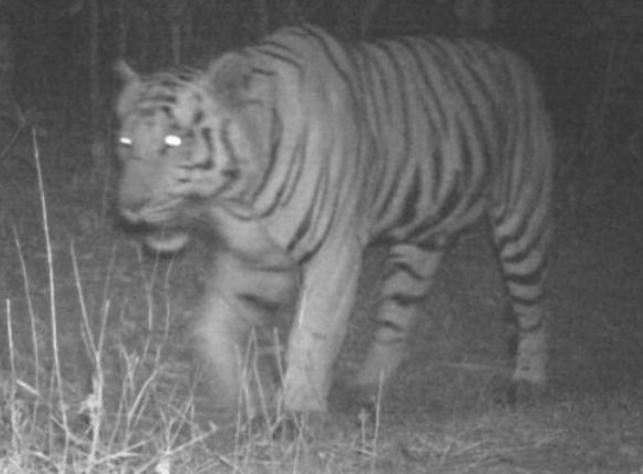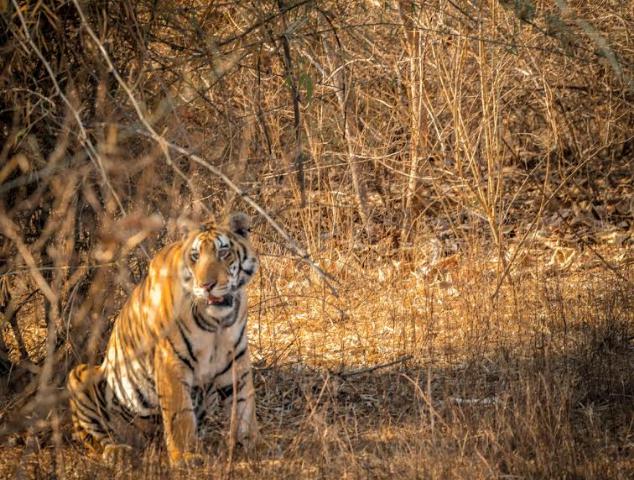The tigers roaming around Bhopal, a phenomenon first of its kind in the world, are required to be radio collared. In all there is movement of 18 big cats in a tiger corridor near the state capital, six of them have become resident tigers of Bhopal. Termed as urban tigers by the state forest department, they are seen venturing near the campuses of the universities situated on city outskirts, government office building premises and parks. Tiger sighting is common on Kerwa and Kaliyasot roads in Bhopal. Radio collaring of these resident tigers would facilitate monitoring of their movements in and around the city. It is also necessary for the safety of the people.
Unforgettable 180 Seconds of Watchman
On February 6- night this year, a tiger sighting was recorded in Bhoj Open University in Bhopal, a terrifying nightmarish experience for the university guards. The tiger entered the bungalow campus of the university vice chancellor after scaling the boundary wall. However, which one of the 18 tigers, it was not known. It might be one of the 6 resident tigers also, said a forest department official. The bungalow is situated in the 25-acre Bhoj University campus, close to Kaliyasot dam. The forest area around the dam is the habitat of tigers. Surprised by the sudden appearance of the tiger, the two watchmen locked themselves inside the duty room. But about 180 seconds spent in doing so were the most horrifying experience of their life. In the haste, one of them fell down. He was too nervous to even gather courage to stand up. Somehow he managed to drag himself to the duty room to bolt the door from inside only to find his colleague trembling with terror. He later told local media, “I had a miraculous escape”. This was not an isolated case.
Also read: Bhopal's Urban Tigers Need Tiger Reserve Not Chain-Links Mr Chief Minister
Many more people have confronted the tigers on the city outskirts in the past more than over 10 years. Students of National Law Academy located on Kerwan dam road, its faculty, residents of the area, owners of the food joints and employees and officials of the Artificial Insemination Training Institute in the same locality have often been surprised by tigers. There are a number of schools and collegesin the region . The government has put up sign boards with caution “Beware, tiger movement area.” It expects people not to move in the picturesque locations.The tiger movement is taking place in a large contiguous area spread over 22 square kms in the jungles around two dams- Kerwa and Kaliyasot and WALMI (Water and Land Management Institute of Madhya Pradesh) located on a hill close to Kaliyasot dam. WALMI campus alone is spread over 200 acres of forest area on the right bank of Kaiyasot.
Radio Collar Will Answer Many Questions
The state forest department has closed the area with a chain link to restrict tiger movement within the forest area. The sprawling 35 hectares of Bhoj university campus is located behind WALMI. These areas are close to the densely populated Kolar road, named after another dam built on the river of the same name. Kolar dam is close to Ratapani Sanctuary, the home to about 60 tigers and also the source population of Bhopal tigers. There is plenty of water in these vast swathes of land because of the number of dams and small water bodies. Abundance of cattle in a large number of gaushalas (cow sheds) located in Kathotiya, Chandanpura (two forested localities near Bhopal) and Kerwa regions provide food for tigers.
Also read: Bhopal Tigers Do Have the Same Fundamental Right to A home As Do We
Besides, there are a number of stray cattle in the whole region. With plenty of food, as many as 18 tigers move from Ratapani to Kheoni sanctuary in Dewas, a functional tiger corridor. Wildlife experts said, “We need to know which tiger is moving where in Bhopal, spending how much time and the route taken by it during the movement?” And this would be possible only with the help of radio collars, an effective tool for monitoring tiger movement. However, the forest department has not even thought about collaring the tigers. “No, we have not sought permission for their collaring,” divisional forest officer Bhopal Alok Pathak confirmed. He said that collaring was not required and the department was looking after the animals well.
Grown up Cubs Marking Territory
Forest department sources said that two sub-adult cubs (T1231,T1233) have started detaching from their mother ( T123 ). About 20 months old, they seem to be making their territory and are seen moving around alone. And this would be a dangerous period when tigers mark their territory. Tigers generally gain independence at around two years of age and attain sexual maturity at age three or four for females and four or five years for males. Juvenile mortality is high, however—about half of all cubs do not survive more than two years. T123 is still accompanied by her female sub – adult (T1234). T3 is the dominant male .Forest department officials who are in favour of the radio collaring of the “urban tigers of Bhopal” said, “the chain linking thrown over 22 sq km area restricting their movement is already changing their behavior. So far nothing untoward has happened but it takes just one moment to break the peace.”
By Deshdeep Saxena
Representational Images, cover image Wikimedia Commons





Comments
Post a Comment